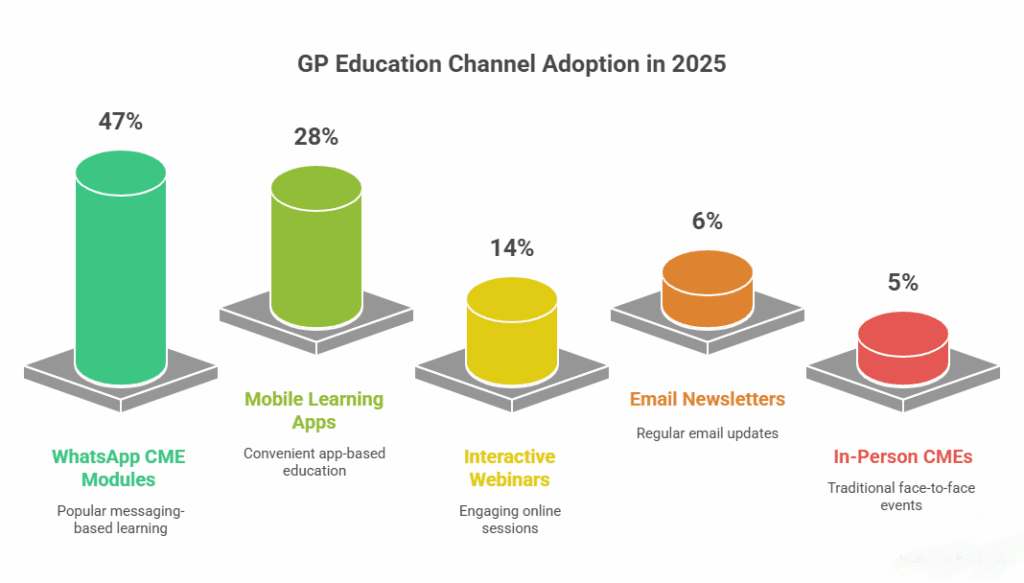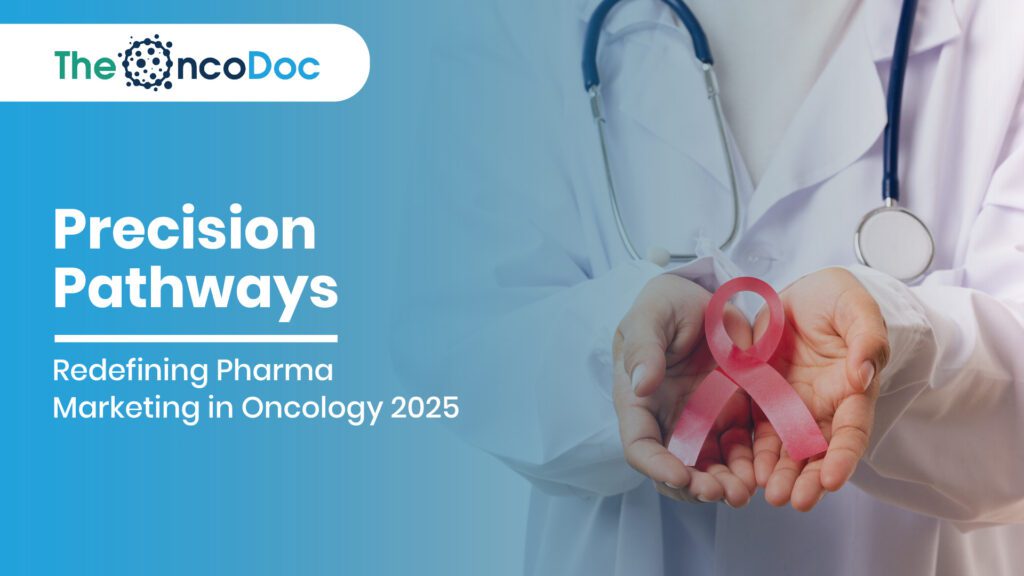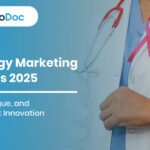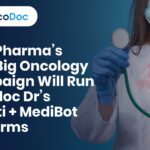Introduction: Oncology Marketing Beyond the Prescription
Pharma marketing in oncology has moved beyond selling treatments-it’s about creating ecosystems of trust, education, and data-driven precision. With AI diagnostics, genomic profiling, and targeted therapies advancing rapidly, oncologists need more than product updates. They need insights, digital tools, and partnerships that truly help patients navigate their cancer journeys.
This article explores the emerging pillars of oncology marketing in 2025, highlighting strategies that transform pharma companies from suppliers into trusted healthcare collaborators.
By reframing marketing as a healthcare support system, companies can build lasting credibility. This shift means brands are measured not just by sales, but by how many patients access early detection and timely treatment. The intersection of empathy and innovation is defining the next era of oncology marketing.
1. Patient-Centric Campaigns at Scale
Pharma marketing now emphasizes patient empowerment. Rather than generic brochures, campaigns are personalized with:
- Short explainer videos on treatment options.
- Multilingual digital toolkits that simplify oncology terms.
- Survivor stories that encourage early detection.
Patients become knowledgeable partners in medical care rather than passive recipients.
Adding empathy-driven patient journeys into marketing ensures that campaigns don’t overwhelm but instead guide patients step by step. Each touchpoint is designed to answer a fear, resolve a doubt, or provide actionable information. This structure makes campaigns feel like genuine support rather than corporate outreach.
2. Data-Driven Market Segmentation
Oncology markets differ regionally, making data segmentation critical. AI tools classify patients and physicians based on:
- Cancer prevalence (lung in industrial zones, oral in rural areas).
- Socioeconomic barriers to treatment.
- Digital behaviors such as symptom searches.
This leads to hyperlocal campaigns that resonate with real-world challenges.
Segmentation also helps brands avoid a one-size-fits-all approach, which often fails in oncology. By aligning campaigns with real epidemiological and cultural insights, pharma ensures relevance. Segmentation effectively serves as a link between the realities of individual patients and population-level trends.
3. General Practitioners: The First Line of Oncology Referrals
Most cancer journeys begin with a GP. Pharma marketers now design CME modules and referral kits tailored for GPs, helping them identify warning signs earlier.

By equipping GPs with simplified screening pathways, pharma closes a crucial diagnostic gap. These strategies not only empower doctors but also accelerate referral timelines, which is vital for oncology outcomes. Every educational module given to GPs potentially translates into earlier life-saving diagnoses.
4. Omnichannel Physician Engagement
From WhatsApp-based updates to AR/VR surgical demos, pharma firms ensure consistent messaging across platforms. This omnichannel model improves recall, trust, and adoption among oncologists.
Instead of fragmenting communication, omnichannel ensures that the same trusted message flows seamlessly whether on mobile apps, clinic kiosks, or email updates. This reduces confusion and increases confidence in pharma-sponsored education. Ultimately, the omnichannel model reflects the reality of how today’s oncologists consume information-anytime, anywhere.
5. Behavioral Nudges for Screening Awareness
Behavioral science is reshaping oncology campaigns. Techniques include:
- Gamified cancer risk assessments.
- SMS reminders aligned with awareness months.
- Rewards for completing diagnostic screenings.
These nudges boost early detection rates significantly.
By leveraging psychology, pharma transforms awareness from a passive campaign into an active patient behavior. Even small nudges-like a reminder sent on birthdays-can significantly improve compliance. Behavioral tools are powerful because they merge human motivation with clinical urgency, ensuring action.
6. Survivor Storytelling: Emotion as a Strategy
Cancer is emotional. Brands leverage real survivor voices to create trust, motivating patients to seek timely care. Campaigns with survivor advocacy achieve far higher engagement than clinical ads alone.
Stories anchor abstract medical concepts in human experience, making campaigns memorable and trustworthy. Survivor-led initiatives also provide inspiration, especially in underserved communities where fear is a major barrier. This blend of fact and feeling ensures that awareness translates into hope and proactive screening.
7. AI-Powered Personalization in Content Delivery
AI platforms curate content for specific individuals. Example:
- A young smoker receives oral cancer screening signals.
- A middle-aged woman is sent a personalized breast cancer self-exam guide.

Personalization allows campaigns to cut through noise and reach patients at the right time with the right message. AI ensures no two patients receive the same generic information. By aligning digital footprints with health needs, pharma creates precision awareness journeys that mirror precision medicine.
8. Vernacular and Cultural Customization
Localized, language-specific campaigns outperform generic English ads. Oncology instruction is made relatable and accessible through folk performances, local radio, and vernacular videos.
Language isn’t just translation-it’s cultural adaptation. When patients hear cancer education in their mother tongue, trust and comprehension rise. Such campaigns demonstrate respect for community identity, which builds stronger connections. In oncology, culture-sensitive messaging can be the difference between suspicion and acceptance.
9. Digital Ecosystems for Oncologists
Pharma firms are building oncology dashboards and AI-driven research summaries, positioning themselves as knowledge partners rather than sellers.
These ecosystems allow oncologists to save time, stay updated, and manage patient data more efficiently. A dashboard that combines drug updates with peer-sharing forums transforms into a digital conference hall available 24/7. By aligning tools with clinical needs, pharma solidifies its role as a trusted collaborator.
10. New Metrics of Success
Clicks and impressions are outdated. Oncology marketing KPIs now include:
- Screenings scheduled via campaigns.
- GP referral rates.
- Patient chatbot engagement.

These new metrics emphasize health impact over vanity numbers. Instead of chasing digital reach, pharma now measures how many patients act, screen, and engage. By tracking outcomes that truly matter in oncology, marketing shifts from promotional activity to public health intervention.
11. Collaborations with Micro-Influencers in Healthcare
Local oncologists, survivors, and even regional NGOs act as trusted messengers, amplifying campaign reach at the grassroots level.
These collaborations often outperform large-scale celebrity endorsements because they bring authenticity. By rooting campaigns in community credibility, pharma ensures messages are not only heard but also acted upon.
12. Predictive Analytics for Campaign Targeting
AI predicts regional cancer surges by tracking online symptom searches. Pharma firms can deploy micro-campaigns in real time, preventing diagnostic delays.
This predictive edge enables proactive interventions rather than reactive responses. In the long run, it positions pharma as a health guardian, rather than a distant industry player.
13. Gamification in Patient Engagement
Risk quizzes, digital badges, and community challenges drive participation in screening drives, adding an element of fun to prevention.
Gamification works especially well with younger demographics who enjoy interactive learning. The approach converts health awareness into an engaging, repeatable experience.
14. Wearables in Preventive Oncology
Smart devices track vitals and lifestyle data, alerting patients to anomalies linked with cancer. Integration with pharma apps makes these insights actionable.
Wearables also create a feedback loop between patients and oncologists, enabling more accurate preventive strategies. As adoption grows, pharma has a unique opportunity to integrate brand value with daily life.
15. Public-Private Partnerships for Wider Reach
Pharma companies co-create screening camps and awareness weeks with state health authorities, NGOs, and local workers-building credibility while saving costs.
These partnerships align pharma efforts with national health priorities. They also allow shared resources, ensuring that campaigns scale beyond corporate boundaries into public health impact.
16. Digital Communities of Care
Pharma-backed online patient forums now provide:
- Access to oncologists through webinars.
- Peer-support spaces for survivors and caregivers.
- Culturally relevant coping resources.
These communities not only provide knowledge but also emotional strength. They create a safe ecosystem where trust builds naturally, beyond the transactional role of pharma.
17. Voice-Tech and IVR in Cancer Education
Voice bots and helplines in local languages bring oncology knowledge to semi-urban and rural communities, overcoming literacy barriers.
With rising smartphone penetration, voice-tech enables hands-free, user-friendly access to healthcare knowledge. It ensures no patient is left behind due to literacy or language constraints.
18. Sentiment Analysis for Campaign Optimization
AI scans patient feedback online. If fear dominates responses, messaging shifts toward reassurance and hope rather than statistics alone.
This agile adaptation improves campaign resonance. By measuring emotions as much as engagement, pharma ensures its campaigns feel supportive rather than corporate.
19. Survivor-Led Advocacy Clubs
Pharma-supported survivor groups host early detection drives in schools, offices, and villages-delivering messages that resonate authentically.
Survivor clubs extend pharma’s reach into highly personal spaces. Their peer-to-peer influence is unmatched, bridging the gap between medical advice and human connection.
20. Immersive AR/VR for Oncologist Upskilling
Pharma firms sponsor 3D tumor biology simulations and VR surgery training, helping oncologists grasp drug mechanisms and rare procedures faster.
Immersive training shortens the learning curve for complex techniques. It ensures oncologists feel empowered and prepared, reinforcing pharma’s position as a partner in education.
21. Chatbots for Patient Navigation
AI chatbots act as virtual triage tools, guiding patients through symptom checks, screening centers, and booking oncology appointments-operational 24/7.
This round-the-clock availability reduces hospital call-center pressure. It also makes oncology information accessible at the precise moment patients need it.
22. Social Listening to Counter Misinformation
Pharma marketers now run fact-check campaigns triggered by online myths, addressing harmful misinformation with credible oncologist-backed resources.
By detecting misinformation early, pharma can intercept harmful narratives before they spread widely. This makes companies active defenders of public health knowledge.
23. Long-Term Survivorship Marketing
Beyond treatment, pharma companies offer recovery nutrition apps, stress management webinars, and follow-up care platforms, deepening loyalty with survivors.
Survivorship marketing emphasizes continuity of care. It ensures survivors feel supported long after therapy, cultivating brand trust that extends across lifetimes.
24. Future Outlook: Precision + Empathy
The next phase of oncology marketing blends predictive AI, hyper-personalized content, and emotionally intelligent storytelling. The winners will be brands that help patients detect cancer early, receive timely care, and rebuild quality of life-while oncologists see them as true partners in advancing care.
The future belongs to strategies that combine technological foresight with human warmth. Pharma companies that achieve this balance will shape not only marketing but the future of cancer care itself.
Conclusion
Pharma marketing in oncology is being rewritten in 2025. It’s no longer about brand promotion, but about life promotion. The fusion of digital intelligence, hyperlocal outreach, and emotional connection ensures that oncology campaigns do more than inform-they save lives.
The essence of modern oncology marketing lies in its humanity. Success will be measured by hope restored, fear reduced, and lives extended-not by market share alone.
The Oncodoc team is a group of passionate healthcare and marketing professionals dedicated to delivering accurate, engaging, and impactful content. With expertise across medical research, digital strategy, and clinical communication, the team focuses on empowering healthcare professionals and patients alike. Through evidence-based insights and innovative storytelling, Hidoc aims to bridge the gap between medicine and digital engagement, promoting wellness and informed decision-making.



